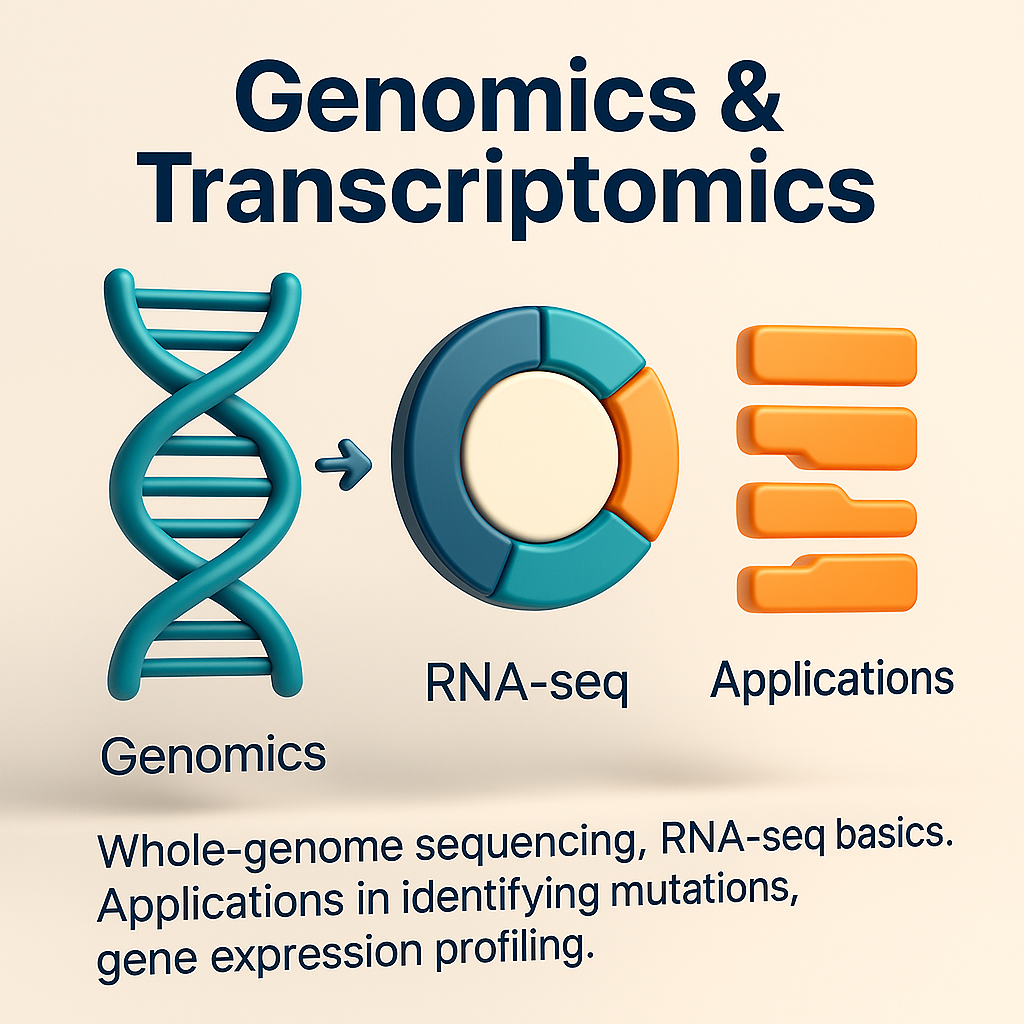
🔬 What is Genomics?
Genomics is the study of the complete DNA (the genome) of an organism.
It involves sequencing, assembling, and analyzing the structure and function of genes.
With the power of whole-genome sequencing (WGS), scientists can decode the entire genetic blueprint of an organism — whether it’s a human, bacteria, plant, or virus.
🧪 What is Transcriptomics?
Transcriptomics is the study of the complete set of RNA transcripts (the transcriptome) produced by the genome under specific circumstances or in a specific cell type.
RNA-seq (RNA sequencing) allows scientists to measure gene expression levels, seeing which genes are turned on or off, and how strongly.
⚙️ Key Techniques & What They Do
| Technique | Analyzes | What it tells us |
|---|---|---|
| Whole-Genome Sequencing (WGS) | Entire DNA sequence | Finds mutations, SNPs, structural variations across the whole genome |
| Exome Sequencing | Coding regions (exons) | Focuses on protein-coding parts, finds disease-causing variants efficiently |
| RNA-Seq | mRNA transcripts | Measures gene expression; which genes are up/down regulated |
| qRT-PCR | Specific RNA targets | Quantifies expression of selected genes precisely |
| Microarrays | Many genes simultaneously | Compares expression patterns across conditions |
🚀 Applications in Biotechnology & Medicine
🧬 Identifying Mutations
-
- Discovering genetic mutations linked to diseases, e.g. cancer, rare genetic disorders.
-
- Comparing healthy vs. diseased genomes to spot single nucleotide polymorphisms (SNPs).
🔬 Gene Expression Profiling
-
- Using RNA-seq to see how genes respond to stress, infections, drugs.
-
- Identifying biomarkers for disease prognosis or drug response.
🌾 Crop & Microbial Genomics
-
- Developing high-yield, stress-resistant plants by finding beneficial genes.
-
- Sequencing industrial microbes to engineer strains with better enzyme production.
💉 Personalized Medicine
-
- Tailoring treatments based on an individual’s genetic profile (pharmacogenomics).
✅ Short summary table
| Area | What is analyzed | Key applications |
|---|---|---|
| Genomics | Entire DNA (genome) | Mutation discovery, disease gene mapping, microbial strain improvement |
| Transcriptomics | RNA (transcriptome) | Gene expression studies, biomarker discovery, studying cell responses |
🔄 Flowchart: From Genomics to Transcriptomics to Functional Analysis
1️⃣ Whole-Genome Sequencing (WGS)
↓
-
- Decode the entire DNA sequence
-
- Identify mutations (e.g. SNPs, insertions, deletions)
2️⃣ RNA-Sequencing (RNA-seq)
↓
-
- Sequence all RNA transcripts (mRNA)
-
- Measure which genes are ON or OFF, and by how much
3️⃣ Functional Analysis
↓
-
- Use bioinformatics tools (BLAST, KEGG, Reactome)
-
- Map affected genes to biological pathways
-
- Predict impact on health, disease, or traits
🧬 Mini case study: BRCA1 mutation & breast cancer risk
🔍 Scenario
-
- A woman has a family history of breast cancer.
-
- Her doctor recommends genetic testing.
🧪 What happens?
-
- Whole-Genome or Exome Sequencing
-
- Reveals a mutation in the BRCA1 gene (a well-known cancer susceptibility gene).
-
- Whole-Genome or Exome Sequencing
-
- RNA-seq on tumor tissue vs. normal tissue
-
- Shows that genes involved in DNA repair are downregulated.
-
- Confirms the impact of the BRCA1 mutation at the expression level.
-
- RNA-seq on tumor tissue vs. normal tissue
-
- Functional analysis
-
- Maps these genes to the DNA damage repair pathway.
-
- Indicates why there’s a higher risk of accumulating mutations ➔ leads to cancer.
-
- Functional analysis
🚀 Outcome
-
- Personalized screening & early intervention plans can be made.
-
- Family members might also choose to get tested.
